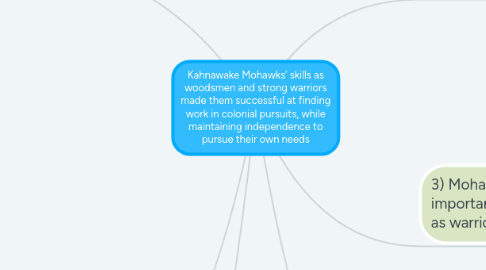Kahnawake Mohawks’ skills as woodsmen and strong warriors made them successful at finding work in colonial pursuits, while maintaining independence to pursue their own needs
by Laura van Wermeskerken


1. 1) Mohawk peoples benefited socio-culturally from participation in colonial industries
1.1. Adaptation to socio-economic changes in the region that limited Mohawk ability to complete traditional tasks for transition to manhood
1.2. Hunting/fishing/trapping to men's responsibilities in Mohawk culture fulfilled in fur trade jobs
1.3. Danger of jobs in lumber and fur trade industries fulfills socio-cultural requirements of Mohawk peoples
1.4. Allowed to leave settlements for long periods of time (maintain independence)
1.5. Very well paid for their work which supported their communities at home
1.6. Subsidized relocation - some marry and have families with locals on their expeditions across the continent
1.7. Continue to be hired, even when many are let go (between wars and after the 1821 merger)
1.8. Ability to work together with other Mohawk as independent units with their own leader
2. Sources
2.1. Sub 1) - David Scott Blanchard, ‘‘Patterns of Tradition and Change: The Re-Creation of Iroquois Culture at Kahnawake’’ (PhD diss., University of Chicago, 1982), 210. - Secondary Source - Nicole St-Onge, ‘‘Trade, Travel and Tradition: St. Lawrence Valley Engages to the American Fur Company, 1818–1840,’’ Michigan Historical Review 34.2 (2008): 17–38. - Secondary Source
2.1.1. - David Scott Blanchard source can be found in the UBC Library - Nicole St-Onge source can be found in the Michigan Historical Review, archived on JSTOR.org or in the archives at Central Michigan University in Mount Pleasant, MI
2.2. Sub 2) - Entry for Pierre Ounawayashon 1816-1821. Hudson's Bay Company Archives (HBCA), F.4/32 Northwest Company Ledger 1811-1821. - Primary Source
2.2.1. The Hudson's Bay Company Archives can be found online on the government of Manitoba website or at the physical archives in Winnipeg, MB
2.3. Sub 3) - Carl Eric Benn, The Iroquois in the War of 1812 (Toronto, 1995). - Secondary Source - Barbara Graymont, The Iroquois in the American Revolution (Syracuse, 1972). - Secondary Source
2.3.1. - Carl Eric Benn source can be found in the SFU Library or accessed online through the SFU Library Catalogue - Barbara Graymont source can be found in the SFU Library
2.4. Sub 4) - Glyndwr Williams and Sir George Simpson London Correspondence Inward from Sir George Simpson, 1841-42. Edited by Glyndwr Williams. With an introduction by John S. Galbraith (Hudson's Bay Record Society, 1973), 43. - Secondary Source
2.4.1. Glyndwr Williams source can be found in the UBC Library
